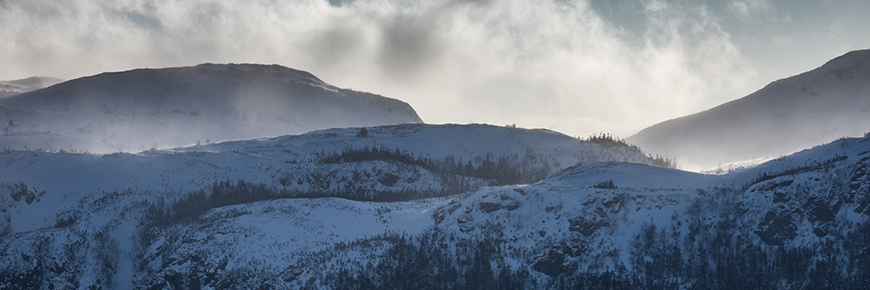The best and most reliable snow conditions are found on the highlands of the Long Range Mountains, the slopes around Bonne Bay, the area around Southeast Hills, and the Tablelands. These areas have the park’s highest snow accumulations, are easily accessible, and have some of its most scenic and varied backcountry terrain. Snow and ice conditions in these areas are most reliable from mid-January through late March but often extend into mid-April.
More gentle terrain is found in the lowlands in the north of the park. However, with an exposed coastal location and many bogs and barrens, this area has less reliable snow conditions. Wind limits snow accumulations and the area is often snow free after winter thaws. Lowland forests will have deeper and more reliable snow.
Note:
• Gros Morne National Park has a maritime climate. Sudden thaws followed by freezing temperatures are common, creating hard packed and icy snow conditions.
• The Tablelands is often wind-blown and frequently icy.
Skiers: Metal-edged backcountry touring skis are generally required for travel on ungroomed snow, especially in areas with steep terrain. Wider skis with full metal edges are preferable and climbing skins are often necessary.
Snowshoers: Mountain or off-trail snowshoes equipped with crampons are preferable and often necessary in the steep terrain of the park.
Avalanche Information
Southwest Gulch (Tablelands)
The Bowl (Tablelands)
Long Range Mountains
Recommendations to follow before leaving
Plan Your Trip:
Plan your route and file a trip plan with a reliable person. A trip plan explains your destination, route, equipment and expected return time. Check out Adventuresmart for an example.
Travel with a companion. There is safety in numbers!
Check the weather forecast before setting out. Be prepared for bad weather, including strong winds that often cause whiteout conditions on the highlands.
Have the skill:
Obtain the knowledge and skills you need before heading out. New backcountry skiers should seek experienced travelling companions or hire a guide.
Trips are best suited to experienced skiers in groups.
There are no marked trails in the backcountry. You require wilderness travel and navigation skills with a map, compass, and/or GPS.
When travelling over ice on ponds or rivers never assume it is thick enough to support you. Always check ice thickness. Ice should be a minimum of 15cm (Canadian Red Cross).
Hypothermia and frostbite are real hazards. Know and understand the signs, symptoms and treatment.
Be avalanche aware. Avalanches occur in the steep terrain of Gros Morne National Park. If travelling in avalanche zones, you should be trained in avalanche safety and carry appropriate safety and rescue gear. Check out Avalanche.ca for information, online training, and access to local courses. With training, you will be able to recognize avalanche slopes, terrain traps and unstable snow conditions necessary for safe route finding.
Take the Essentials:
Make sure you are well equipped and ready for an emergency. Cell coverage throughout the backcountry is very limited. Be prepared to extend your outing should it become necessary. Carry these and know how to use them:
Extra insulating clothing, spare socks & gloves, and a base layer.
Extra food, water (especially high calorie snacks)
Navigation and communication devices
Headlamp (extra batteries)
Signalling device (whistle)
Pocket knife
Sun protection
Sunglasses and/or ski goggles
Emergency blanket/shelter
Other equipment specific to your activity (pack shovel, repair kit, duct tape, multi-tool, cord, avalanch gear)
Check out “The 10 Essentials” (Adventuresmart).
